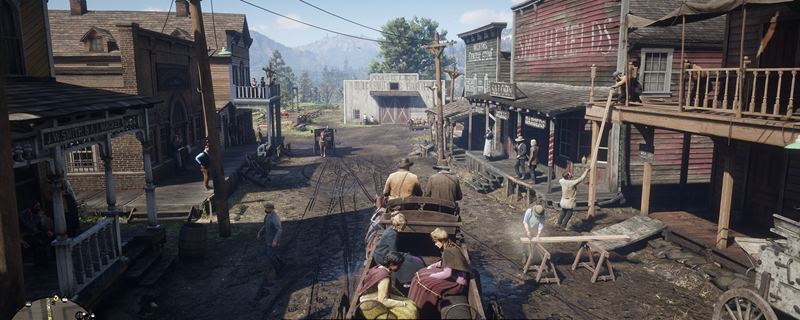Red Dead Redemption 2 PC Performance Review and Optimisation Guide
Conclusion – Is Red Dead Redemption 2 Unoptimised? Â
Personally speaking, I dislike the term unoptimised when it comes to PC gaming. It implies that demanding graphical settings are a fault and not a feature. Yes, the inability to run a game at maxed-out settings may seem like a problem on launch day, but a few years down the line and a few system upgrades later and you might be singing a different tune.Â
Red Dead Redemption 2’s PC version is a controversial release, mostly thanks to its high hardware demands at its highest settings and teething issues with Rockstar’s game launcher. Another factor that plays into this is branding, most PC gamers expect to play “console ports” with settings set to High or Ultra, but in the case of Red Dead Redemption 2, many gamers will need to settle with Medium or low to hit a 60FPS framerate target.Â
If we’re honest, a lot of Red Dead Redemption’s Low settings should be called Normal, many Medium settings should be called High, most High settings should be called Ultra, and many Ultra settings should be called “Maximum”, “Extreme” or some other fancy word. Red Dead Redemption 2 should be treated like the original Crysis, a game that was created with graphical settings that have future hardware generations in mind.Â
Red Dead Redemption 2’s graphical presets are a joke, being different for every graphics card we tested (except for max), making this game challenging when it came to comparative GPU testing. We worked around this by creating custom/optimised presets for our Low, Medium, and High testing.Â
If you have a graphics card with 4GB of VRAM or more, you should be using Red Dead Redemption 2’s Ultra textures. Since most PC gamers with a post-2016 graphics card will have at least 4GB of memory, we decided to use Ultra textures for our optimised low, medium and high custom presets. This allowed Red Dead Redemption 2 to look great, even while most other settings were set to low. We also made sure that even our low preset had specific settings set high enough to ensure a great visual experience. For example, we didn’t turn the game’s Grass or Geometry LODs all the way down. Remember that these are optimised settings, and if you look at pages 3 and 4 of this analysis, you will see that all of our presets present pleasing visuals.   Â
Those who are looking for quick performance tips should know that Red Dead Redemption 2’s Volumetrics Quality setting can be lowered to Medium with a relatively minor graphical impact while yielding performance boosts as high as 15%. With enough graphical tweaks, PC gamers can almost double their game performance while maintaining solid visuals. This highlights another perceived problem with Red Dead Redemption 2’s PC release; players need to do the game’s graphical optimisations themselves. That’s why we created our optimised presets on page 2.Â
Rockstar has launched Red Dead Redemption 2 with support for both DirectX 12 and Vulkan, giving PC gamers a choice between both APIs. Our guess is that DirectX 12 was originally Rockstar’s API of choice, but the arrival of Google’s Stadia platform forced the developer to shift its efforts into Vulkan. Rockstar’s Stadia version of Red Dead Redemption 2 will utilise the Vulkan API, so it makes sense for the developer to put more effort into it. Red Dead Redemption 2 selects Vulkan by default, requiring PC players to switch to DirectX 12 manually, somewhat supporting this theory. In our testing, DirectX 12 proved to be both buggy and less performant, making Vulkan our favoured API for this game.
CPU-wise, we found that our ageing i7-6850K was able to play this game at 60+FPS framerates easily. That said, it is clear that Red Dead Redemption 2 favours processors with more than four cores/threads. As we have said many times before, PC gaming has moved past the “a good quad-core is enough” era. A quad-core processor with hyperthreading or SMT is a great match for Red Dead Redemption 2, or better is you want to target higher framerates.Â
For the most part, Red Dead Redemption 2 seems to favour Radeon graphics cards, with AMD’s RX 5700 XT offering similar performance to Nvidia’s more expensive RTX 2070 Super. AMD’s ageing RX Vega 56 can also give Nvidia’s RTX 2060 Founders Edition a run for its money. That said, with AMD having no graphics card above its RX 5700 XT, team Geforce still rules the roost at the ultra-high-end of the PC gaming market.Â
If you are the kind of PC gamer that demands to play the latest games at Ultra, Red Dead Redemption 2’s PC version won’t satisfy you. If you can rename these settings in your head or simply make some settings sacrifices, there is a great looking game here that can run well on most modern systems. Our biggest criticism of Red Dead Redemption 2 is that settings optimisations can take a lot of time and effort.Â
Having read this analysis, you should be a lot better equipped to deal with Red Dead Redemption 2’s insane number of graphics options. Hopefully, our custom/optimised graphical settings can serve you well when trying this game out for yourself. Tomorrow we plan to release the video component of this review, which will discuss many of the topics mentioned in this analysis. Â
Update – Here is the video portion of our PC Performance Review of Red Dead Redemption 2.Â
You can join the discussion on Red Dead Redemption 2’s PC Performance and how to optimise the game’s graphical settings on the OC3D Forums.Â



